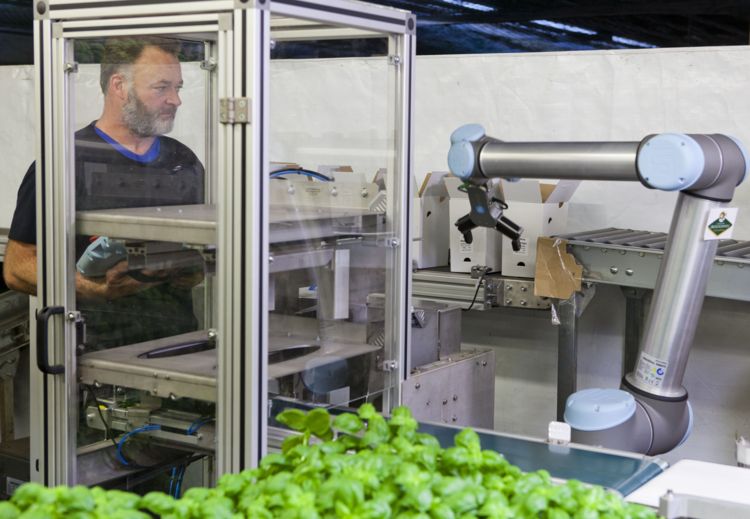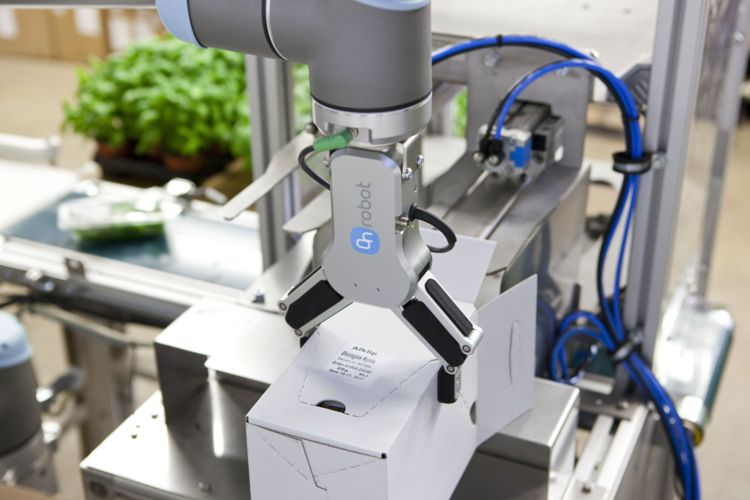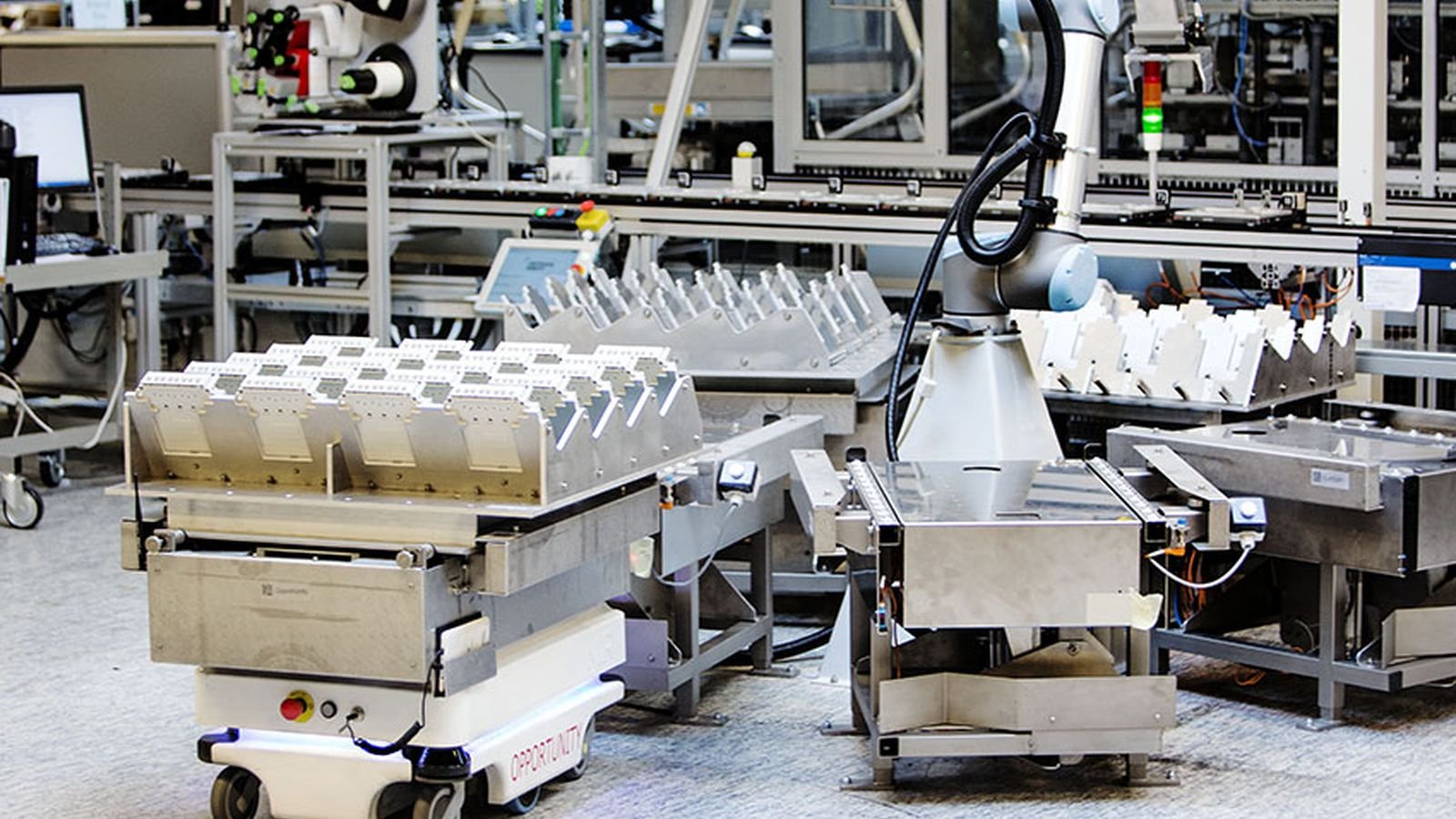
Rosborg Food Holding, Denmark's largest producer of herbs and miniature plants, uses a collaborative robot in its packaging operations to pick up pots of herbs from a conveyor belt and place them in cartons. The robot is also used to pick up and position cardboard boxes in place for another machine to insert pre-packaged salad
The use of herbs was already common in Babylon about 4,000 years ago. The ancient Egyptians and Greeks developed and refined the cultivation of herbs for the up-and-coming art of healing and as a culinary delicacy. In the 21st century, it is robotic technology that increasingly provides us with herbs as a fragrant, tasty food.
In Odense, Denmark, Rosborg Food Holding’s greenhouses cover around 120,000 square metres. Mint, dill, tarragon and other delicious plants as well as miniature roses thrive in a state-of-the-art production facility. Here, a total of 130 employees produce, pack and sell 28 million herbal plants and 12 million miniature plants, which go by product names such as Gloria Mundi, Økologihaven or Eurostar. The Danish plant breeding company has been producing spices and mini flowers for retail and catering sectors since 1980. However, it can only meet the constantly growing demand for its broad product range subjected to a high degree of seasonality by comprehensive rationalization and automation measures.
Better working conditions with higher productivity
“We are continuously working to improve the productivity and efficiency of our processes,” says Henning Jørgensen, partner and plant manager of Rosborg Food Holding. “By finding automation solutions for monotonous, physically demanding tasks, we can relieve our employees. At the same time, it helps us to reduce the number of overtime hours and the employment of temporary staff”.

The executives at Rosborg were looking for a way to increase available capacities in day-to-day operations to be able to double production at peak times such as Christmas, New Year’s Eve or Easter without losing revenue due to overtime and replacement workers. “So far, our profit margins have been shrinking at such times with high production volumes. That’s why our employees have a positive attitude towards the prospect of using collaborative robot technologies as production support in order to work more efficiently and reduce overtime,” Jørgensen describes the situation.
In 2013, a new owner initiated a fundamental modernization process of the company’s entire production. 37 million Danish crowns were invested in new, highly efficient greenhouses equipped with automation technology and robots. At the same time, Rosborg has expanded its product range to meet the growing demand for herbs other than those traditionally used in Scandinavian cuisine. In addition to robots and employees, ten different types of useful insects operate in the greenhouses to keep pests away from the plants.
Robot hand with a sense of touch
One of the latest automation investments is a flexible packaging line with a so-called “Cobot” from Universal Robots, a collaborating robot equipped with an RG6 gripper from OnRobot. The two “fingers” of the robot gripper feature intelligent, advanced technology, that mimics the human sense of touch when intuitively gripping and moving objects.
“We were looking for a gripper that could gently lift the herbs and flowers without crushing them,” explains plant manager Jørgensen. “We chose an R6G gripper, which is characterized by gentle and careful gripping movements as well as precision and flexibility. Our new solution automates the folding of packaging cartons and the placement of herbal fine cuts in the folding boxes.”
The new generation of collaborative robots places extremely diverse demands on the robot hand at the end of the robot arm. “What the gripper needs to be capable of depends entirely on the selected task,” says Enrico Krog Iversen, CEO of OnRobot. “The more user-friendly, flexible and careful the gripper is, the greater the variety of tasks that can be automated, and the faster the robots and grippers pay off for the buyer.” This is also confirmed by Jørgensen: “When choosing our solution, the best possible payback period was of course a crucial factor.”
A playful and successful start
Rosborg Food chose a playful, interactive approach for the introduction of robotics in Denmark. “Before we even knew what exactly we wanted to automate, we purchased a robot arm and a gripper via the MELCNC integrator,” says Jørgensen. “We’ve experimented with it and invented some funny applications.” In this way, the employees got to know the robot arm and gripper right from the start as an easy-to-use, helpful tool. “Once we programmed the Cobot so that it could write the boss’s name on a blackboard on his birthday. And at the official inauguration of a new greenhouse, the robot handed over the scissors to Jane Jegind, member of Odense City Council, so that she could cut the red ribbon,” recalls the plant manager.

Configurating the applications and the automated packaging solution is so intuitive that even employees without prior experience can do it. It is sufficient to simply adjust the settings on the touch screen of the robot arm, for instance to configure the application for packaging other types of products. The software for controlling the RG6 gripper is extremely user-friendly, too. At the touch of a button, it can be installed on the robot arm like an app on a smartphone.
Henning Jørgensen is already planning the next steps regarding the automation of Rosborg Food Holding: “The next project will be the acquisition of a further collaborating robot with a gripper suitable for equipping a cutting machine for the herbs.” Perspectively, arm and gripper are supposed to carefully pick up the plants, turn them and then place them on the conveyor belt to the cutting machine.





